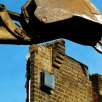Audiovisual Montage
- 1
- 1.1
- 1.2
- 1.3
- 1.4
- 2
- 3
- 4
In classic film experience, viewers and listeners perceive the images and sounds as a whole, just as in everyday reality visible and audible elements are directly linked. However, when producing a film, these two parallel worlds must first be designed to create an audiovisual entity and linked in such a manner that they generate an integrated receptive experience.
Since the early days of what were back then still silent movies, the montage of images, in other words the narrative, rhythmic, emotionally coherent assembly of edited film frames has always been an art in itself. The viewers had to and still must orientate themselves in space and time and be able to follow the plot with its series of events and protagonists. With the emergence of sound film as a technical possibility for combining image and sound, the spectrum of montage was extended to also include auditive aspects. However, the linking of the two means of perceiving — hearing and seeing — in the audiovisual montage does not only require further technical cinematographic developments, but also calculates dramaturgical and aesthetic strategies for making the film experience more comprehensive. A prerequisite is the possibility provided by media practice to edit image and sound levels autonomously, to separate them and recombine them, to change them and supplement them, and finally bring them together to create an audiovisual whole.
Works: Kinetophone, Star Wars, M, The Conversation, Apocalypse Now, Jurassic Park, Phonograph, Black Box BRD, Touch the Sound, Berlin: Die Sinfonie der Großstadt, Deutscher Rundfunk, Melodie der Welt, Man with a Movie Camera, Prospero's Books, Audio-vision: Sound on screen.
People: Hanns Eisler, Steven Spielberg, Walter Ruttmann, Jean-Luc Godard, Thomas A. Edison, Michel Chion, Dziga Vertov, Francis Ford Coppola, Walter Murch, Fritz Lang, John Smith, Elizaveta Svilova, Jack Foley, David Lynch, Andres Veiel
Socialbodies: The Doors, Deutsche Bank AG, montage AV. Zeitschrift für Theorie & Geschichte audiovisueller Kommunikation.




